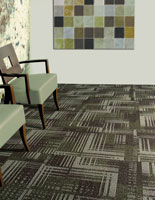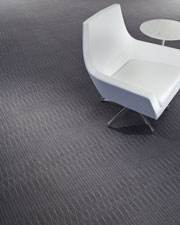Despite the impact of the recession on the commercial sector, contract’s largest flooring category has not only maintained its leadership position in the green movement, its product mix has continued to be driven more by modular styles as opposed to broadloom.
Financially, the category has been hit as hard as any other. The good news is the declines appear to be slowing; when 2010 is in the books, sales are expected to be off high single digits—a vast improvement over the 25% to 30% drop most saw in 2009. In terms of overall sales, some are estimating the segment could fall below the $3 billion mark by year’s end—and closer to $2 billion when Main Street is taken out of the picture—thus giving back virtually everything it had gained in the decade leading up to the recession.
This feeling that the light at the end of the tunnel can be seen is not something just being touted by the mills. At the recent Starnet and ReSource conventions, many of the industry’s largest flooring contractors sported the sentiment, “If we can hold on over the summer, the fall is starting to look decent. And, if we can get through this year, things are looking up in the long run.”
Even though the market remains in a depressed state, there have been bright spots nonetheless, most notably the continued shift to more modular carpet being used in the specified market. As proof, Interface, the industry’s largest manufacturer of carpet tile, reported in its first-quarter earning statement that its modular carpet segment was up 9.9% over the same period in 2009. While the Asia-Pacific region continues to be a growth area for the company, net sales for carpet tile in the Americas still grew at a healthy 9%.
 John Wells, senior vice president, called the carpet tile segment the industry’s “most dynamic. It has continued to take share, even during the downturn.” He believes this is because “it is a format that makes the most sense,” noting it is even more so following innovations such as the company’s TacTiles, which are glue-free adhesive squares that adhere tiles to one another and create a floating floor.
John Wells, senior vice president, called the carpet tile segment the industry’s “most dynamic. It has continued to take share, even during the downturn.” He believes this is because “it is a format that makes the most sense,” noting it is even more so following innovations such as the company’s TacTiles, which are glue-free adhesive squares that adhere tiles to one another and create a floating floor.
James Lesslie, president of Beaulieu Commercial, agreed with Wells’ assessment. “Carpet tile has continued to be a growth area even with the overall industry’s decline over the last three to four years. In the pure specified market tile is now at least 50% of the pie.”
Al Kabus, president of The Mohawk Group, noted two years ago roughly 65% of the company’s commercial carpet sales were in broadloom; today the mix is closer to 50/50. “Tile is growing faster than broadloom. In fact, it is accelerating through the downturn in terms of share.”
Seeing green
The other positive centers around the green movement. While green/sustainability has been a topic in commercial long before it reached the residential market, executives note as the concept becomes more mainstream, it has not only continued to show growth, but has actually been boosted as a result.
“Sustainability definitely has significantly impacted both products and specs,” said Jeff West, director of sustainability for Shaw Commercial. “From specifications, we see increased requests for both post-consumer and pre-consumer recycled content. We also see specs requiring specific chemical avoidance and multiple third party product certifications. Additionally, our sustainability questions and request-for-proposal questions relative to  sustainability have grown exponentially in the last three years. These questions are asking about life cycle assessment (LCA), product certifications, social practices such as diversity or social causes, and specific environmental metrics—water, energy, waste, etc.”
sustainability have grown exponentially in the last three years. These questions are asking about life cycle assessment (LCA), product certifications, social practices such as diversity or social causes, and specific environmental metrics—water, energy, waste, etc.”
As a result of this, “Innovations and market influences have led to the development of products with increased recycled content, products with a lower environmental footprint and the development of safer or alternative chemicals/products.”
David Vita, Beaulieu’s executive vice president of sales, added, “While the growth of environmental initiatives into the residential market has increased exposure, we need to maintain a fact-based approach to the information we deliver to our clients.” He noted the increased exposure can have a negative effect in that it produces greenwashing.
Along with the consumer now seeking more environmentally friendly products, executives point to recent actions in places like California as another major reason for the A&D community wanting to use green carpet: the widespread adoption of NSF-140, the national carpet sustainability standard.
“With the passing of the new Government Services Administration’s (GSA) specification built around performance and sustainability, there is a broader acceptance of NSF-140 both in government and private sectors,” Mohawk’s Kabus explained. “For example, NSF-140 is mandated in California (FCNews, May 3/10), and New York has adopted the GSA specification. The impact of environmental consciousness has swept the industry, and I believe most projects today begin with green in mind.”
Interface’s Wells said the more green becomes mainstream the more it will help create a demand for these types of products, but he cautioned consumers are becoming confused because “everyone has a green product. That’s why transparency will be important so the end user knows what’s better, and NSF-140 has helped raise the bar.”
Bob Baird, business manager for Milliken Contract Global, said the company “welcomes and encourages standards that eliminate confusion around sustainability [and] simplify the process for customers to make decisions based on facts rather than individual interpretations.”
Shaw’s West believes that even though California’s “early adoption of the principles and protocol, specifically at the platinum level, helped the momentum in the state as well as the rest of the U.S. [and beyond]—we are also seeing some spec requirements outside the U.S. for NSF-140.” Key reasons as to why it has garnered so much support is because “it is a multiple-attribute certification that is focused specifically on carpet and because the standard was formed in a consensus-based format.”
